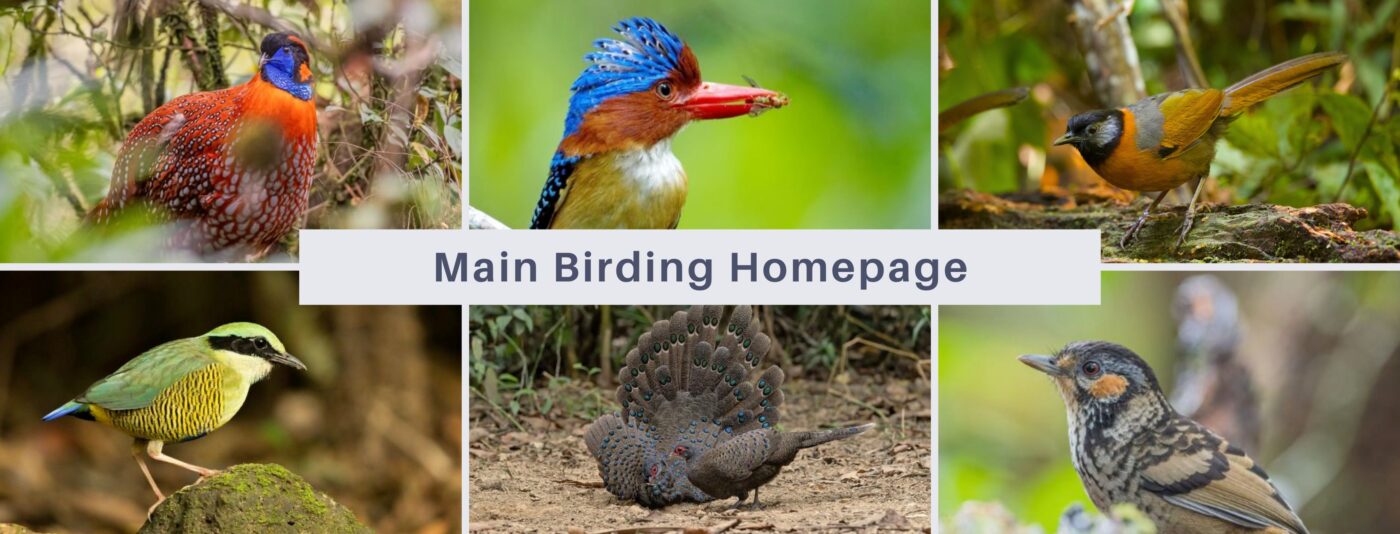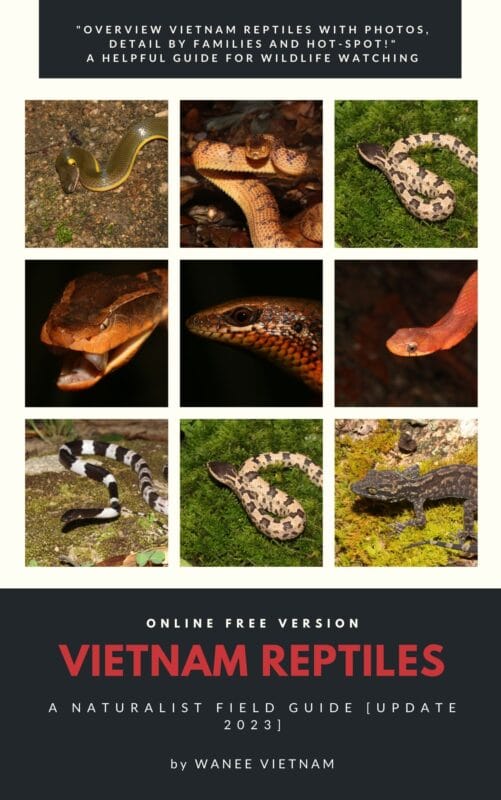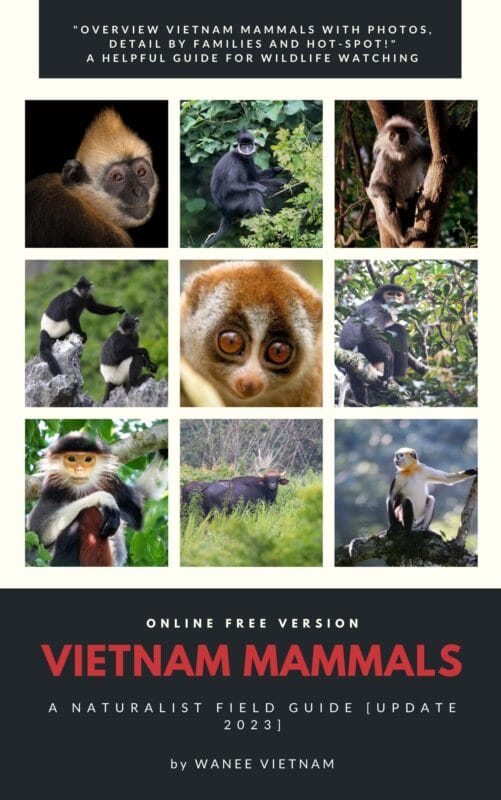Introduction to wildlife watching in Vietnam
Wildlife watching in Vietnam is a must-do activity for nature lovers, birders, and wildlife enthusiasts. With its diverse geography, including mountains, forests, wetlands, and coastlines, Vietnam is home to an incredible range of unique and fascinating wildlife, including over 900 species of birds, dozens of mammal species, and a vast array of reptiles, amphibians, and insects.

In this beginner’s guide, we’ll explore some of the best tips and tricks for a successful wildlife watching trip in Vietnam, including the different types of animals and birds that can be found, as well as the popular regions for wildlife watching, such as national parks, nature reserves, and other protected areas. Whether you’re a seasoned wildlife watcher or a first-timer, this guide will help you plan and enjoy an unforgettable wildlife watching experience in Vietnam.

When is the best time to go?
Vietnam is a country with diverse and unique wildlife, making it a great destination for wildlife watching. However, the best time to go wildlife watching in Vietnam depends on several factors, including the weather conditions, animal migration patterns, and breeding seasons. The best time to visit Vietnam for wildlife watching is typically during the dry season, which runs from November to April. During this time, the weather is typically dry and sunny, making it easier to spot wildlife.
The specific timing within the dry season can vary depending on the region of Vietnam, so it’s important to research the specific areas you plan to visit. For example, in the northern part of Vietnam, the best time for wildlife watching is typically from September to April. During this time, the weather is cool and dry, and many bird species are present.
In central Vietnam, the dry season lasts from February to August, making this the best time to visit for wildlife watching. During this time, the weather is sunny and warm, and many species of primates and birds can be found.
In the southern part of Vietnam, the dry season runs from November to April, making this the best time for wildlife watching. During this time, the weather is dry and cool, and many species of reptiles, amphibians, and birds can be found in areas such as Cat Tien National Park and the Mekong Delta.
It’s important to note that some species may be easier to spot during specific times of the day. For example, many bird species are most active during the early morning and late afternoon, while some primates may be more active during the mid-morning to early afternoon. Doing some research on the specific species you hope to see can help you plan your wildlife-watching activities more effectively.
Are you looking for Wildlife Tours in Vietnam?
WANEE VIETNAM is the right place for the "Wildlife Tours in Vietnam", we specialize in Birding, Wildlife watching, Herping, Photography-tours and general Edu-tours by our experts.
What are the top wildlife-watching spots in Vietnam?
Vietnam is a country blessed with a diverse range of ecosystems, from lush rainforests to rugged mountains and pristine coastal areas, making it a prime location for wildlife watching. Here are some of the top wildlife-watching spots in Vietnam:
- Cat Tien National Park: Located in the southern part of Vietnam, Cat Tien National Park is a vast protected area that is home to a wide range of wildlife species, including elephants, bears, deer, monkeys, and hundreds of bird species. You can explore the park on foot or by jeep, and there are several accommodation options within the park.
- Ba Be National Park: This beautiful national park in the northern part of Vietnam features stunning lakes, waterfalls, and forests, and is home to several rare animal species, such as the white-browed gibbon and the black giant squirrel. You can take a boat ride on the lake, hike in the forest, or visit the nearby ethnic minority villages.
- Phong Nha-Ke Bang National Park: Known for its stunning caves and limestone formations, this national park in central Vietnam is also a prime location for wildlife watching. The park is home to several rare species, including the Hatinh’s Langur, the Truong Son muntjac (a type of deer), and the Annamite striped rabbit. You can take a jungle trek or visit the park’s underground caves.
- Cuc Phuong National Park: One of the first national parks in Vietnam, Cuc Phuong is located in the northern part of the country and features a diverse range of wildlife, including primates, birds, and reptiles. The park also has a rescue and rehabilitation center for primates, including several species of langurs and gibbons.
- Yok Don National Park: Situated in the central highlands of Vietnam, Yok Don National Park is a vast protected area that is home to several rare species, such as the Asian elephant… You can explore the park on foot or by jeep, and there are several accommodation options nearby.
These are just a few of the many wildlife-watching spots in Vietnam, each with its own unique wildlife and landscapes to discover.
Learn all about Wildlife Destination in Vietnam HERE!
Which the essential gear and equipment should prepare to the trip?
When preparing for a wildlife-watching trip in Vietnam, it is important to have the right gear and equipment to ensure a successful and enjoyable experience. Here are some essential items to consider:
- Binoculars: A good pair of binoculars is essential for spotting birds and other wildlife in their natural habitat. Look for lightweight and waterproof models that offer good magnification.
- Camera: To capture the breathtaking beauty of the wildlife and landscapes in Vietnam, a quality camera is a must. Consider bringing a zoom lens and a tripod for stable shots.
- Comfortable Clothing: Dress in layers for variable weather conditions, and wear sturdy footwear for walking and hiking on uneven terrain.
- Insect Repellent: Mosquitoes and other biting insects can be a nuisance, so be sure to bring plenty of insect repellent.
- Water Bottle: Staying hydrated is crucial for outdoor activities, so bring a refillable water bottle to avoid plastic waste.
- Sun Protection: Vietnam can be hot and sunny, so bring a hat, sunglasses, and sunscreen to protect yourself from harmful UV rays.
- Field Guide: A field guide to the birds and wildlife of Vietnam can be a helpful tool for identifying and learning about the different species you may encounter.
Note for safety tips!
It is important to prioritize safety to ensure a successful and enjoyable experience. Here are some safety tips to keep in mind:
- Be aware of your surroundings: Always keep an eye out for any potential dangers, such as venomous snakes or aggressive animals. Stay on designated trails and avoid straying off the beaten path.
- Follow local guidelines and regulations: Each wildlife watching destination may have its own specific guidelines and regulations, so be sure to do your research beforehand and adhere to these rules.
- Respect the animals: Remember that you are a guest in the animals’ home, so always respect their space and avoid getting too close or disturbing them in any way.
- Be prepared for emergencies: Always carry a first-aid kit, sufficient water, and a communication device in case of emergencies.
- Dress appropriately: Wear appropriate clothing and footwear for the weather and terrain, and consider using insect repellent to avoid insect bites or diseases.
How to respectful behavior for wildlife?
As you embark on your wildlife watching adventure in Vietnam, it’s important to remember that you are a visitor in these animals’ homes. To ensure their safety and preserve their natural habitats, it’s important to be respectful and responsible while observing them. Avoid touching or disturbing the animals and their habitats, and never leave any trash or litter behind. Follow the guidelines and regulations set by the local authorities and tour operators, and be mindful of your impact on the environment. By practicing responsible behavior, you can help ensure that these magnificent creatures will continue to thrive for generations to come.
Hiring a guide, is good?
Hiring a guide can greatly enhance the experience of wildlife watching in Vietnam. While it is certainly possible to explore national parks and nature reserves on your own, a knowledgeable guide can provide valuable expertise and insights into the local wildlife and their behavior.
One of the main benefits of hiring a guide is their expertise in identifying the animals and birds you encounter. Vietnam is home to a diverse range of species, some of which can be difficult to spot or identify without prior knowledge. A guide can help you distinguish between similar species, and point out the unique characteristics and behaviors of each one.
In addition to identifying the wildlife, a guide can also provide valuable insights into their behavior and habitat. They can point out specific plants and trees that are used as food or shelter by different animals, and explain the interdependence between different species in the ecosystem.
Furthermore, a guide can help you find the best locations and times for wildlife watching. They are familiar with the local landscape and animal behavior, and can take you to areas where you are most likely to encounter the animals you are interested in. This can save time and increase the chances of having a successful wildlife watching experience.
Finally, hiring a guide can help support the local economy and conservation efforts. Many local guides are trained in environmental conservation and can provide education and awareness about the importance of protecting the natural habitats of these animals.
How about local customs and culture in the nature areas?
In addition to being respectful of the wildlife, it’s also important to be respectful of the local customs and culture when wildlife watching in Vietnam. For example, some communities may have beliefs or traditions surrounding certain animals that may impact how they are viewed and treated. Additionally, you should be aware of any restrictions or guidelines in place to protect the environment and wildlife. By researching and respecting the local customs and culture, you can have a more enriching and enjoyable experience while also supporting the local communities.
How its contribute for environmental conservation?
Environmental conservation is of paramount importance in Vietnam, a country rich in biodiversity and unique wildlife. As the demand for wildlife experiences increases, it’s essential that conservation efforts keep pace to ensure the long-term survival of these animals and their habitats.
Wildlife watching can play a significant role in promoting conservation efforts by raising awareness of the importance of protecting the environment and its inhabitants. By supporting responsible and sustainable wildlife watching activities, you can contribute to the conservation of the areas they visit.
Additionally, supporting local conservation organizations or eco-tourism companies can help to fund important research and conservation efforts, and ensure that the benefits of wildlife watching are shared with the local communities who live alongside these important habitats.
Helpful online Free Nature Guides for Wildlife-watching in Vietnam
This online nature guide helps you to go through the diversity of Vietnam’s Wildlife and have a good prepare for the coming trip.
![A Beginner's Guide to Wildlife Watching in Vietnam: Tips and Tricks for a Successful Trip 11 ONLINE free Version - VIETNAM BIRDS - A Naturalist field guide [update 2023] - by WANEE VIETNAM](https://wanee.asia/wp-content/uploads/2023/02/Black-and-White-Modern-Collage-Photography-Book-Cover-501x800.jpg)

Reptiles of Vietnam

Mammals of Vietnam
Final for A Beginner’s Guide to Wildlife Watching in Vietnam!
With a little planning and preparation, you can explore the diverse habitats of Vietnam and encounter a wide variety of animals and birds in their natural habitats. We hope that this beginner’s guide has provided useful tips and tricks to help you plan a successful wildlife watching trip to Vietnam.
Remember to respect the environment, follow local guidelines, and hire a guide for the best experience. With Vietnam’s stunning landscapes and diverse wildlife, there is no better time to start planning your own wildlife-watching adventure. So pack your bags, grab your binoculars, and get ready for an unforgettable journey into the heart of Vietnam’s natural beauty.
Dalat Plateau Birding Herping and Wildlife Tours
The Dalat Plateau, rising 2,000 meters above sea level, is one of Vietnam’s most important [...]
Cat Tien National Park Birding Herping and Wildlife Tours
Cat Tien National Park tours offer an unforgettable experience with sightings of Germain’s Peacock Pheasant, [...]
Western Black Crested Gibbon – Nomascus concolor
Nestled within the verdant landscapes of Vietnam, the Western Black Crested Gibbon (Nomascus concolor) emerges [...]
Northern White-cheeked Gibbon – Nomascus leucogenys
The northern white-cheeked gibbon (Nomascus leucogenys) is a Critically Endangered gibbon species indigenous to South [...]
Northern Yellow-cheeked Crested Gibbon – Nomascus annamensis
The Northern Yellow-Cheeked Crested Gibbon, or Nomascus annamensis, is an exclusive primate species found in [...]
Eastern Black Crested Gibbon – “Cao-vit Gibbon” – Nomascus nasutus
Nestled within the dense, emerald-green forests of Vietnam, the Eastern Black Crested Gibbon (Nomascus nasutus), [...]